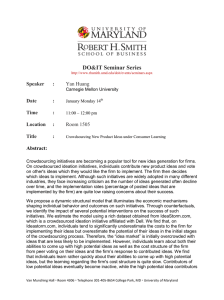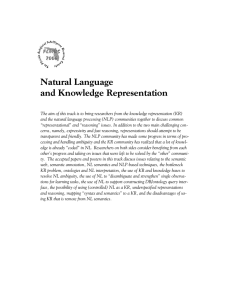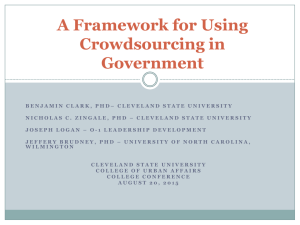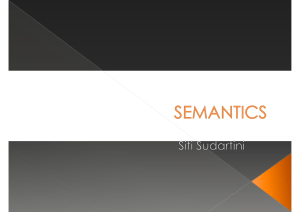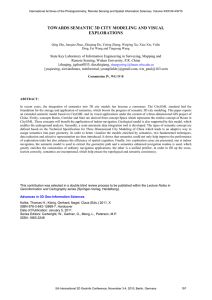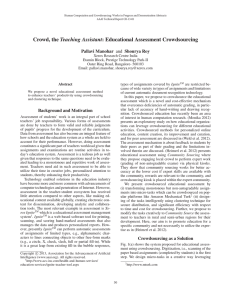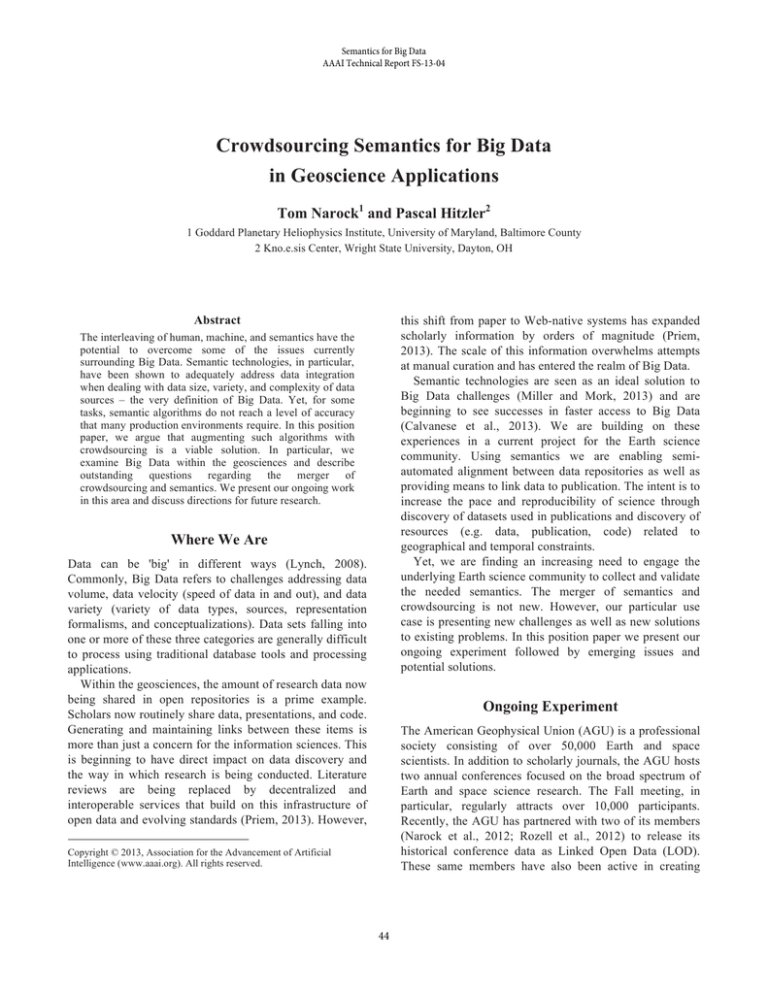
Semantics for Big Data
AAAI Technical Report FS-13-04
Crowdsourcing Semantics for Big Data
in Geoscience Applications
Tom Narock1 and Pascal Hitzler2
1 Goddard Planetary Heliophysics Institute, University of Maryland, Baltimore County
2 Kno.e.sis Center, Wright State University, Dayton, OH
Abstract
this shift from paper to Web-native systems has expanded
scholarly information by orders of magnitude (Priem,
2013). The scale of this information overwhelms attempts
at manual curation and has entered the realm of Big Data.
Semantic technologies are seen as an ideal solution to
Big Data challenges (Miller and Mork, 2013) and are
beginning to see successes in faster access to Big Data
(Calvanese et al., 2013). We are building on these
experiences in a current project for the Earth science
community. Using semantics we are enabling semiautomated alignment between data repositories as well as
providing means to link data to publication. The intent is to
increase the pace and reproducibility of science through
discovery of datasets used in publications and discovery of
resources (e.g. data, publication, code) related to
geographical and temporal constraints.
Yet, we are finding an increasing need to engage the
underlying Earth science community to collect and validate
the needed semantics. The merger of semantics and
crowdsourcing is not new. However, our particular use
case is presenting new challenges as well as new solutions
to existing problems. In this position paper we present our
ongoing experiment followed by emerging issues and
potential solutions.
The interleaving of human, machine, and semantics have the
potential to overcome some of the issues currently
surrounding Big Data. Semantic technologies, in particular,
have been shown to adequately address data integration
when dealing with data size, variety, and complexity of data
sources – the very definition of Big Data. Yet, for some
tasks, semantic algorithms do not reach a level of accuracy
that many production environments require. In this position
paper, we argue that augmenting such algorithms with
crowdsourcing is a viable solution. In particular, we
examine Big Data within the geosciences and describe
outstanding questions regarding the merger of
crowdsourcing and semantics. We present our ongoing work
in this area and discuss directions for future research.
Where We Are
Data can be 'big' in different ways (Lynch, 2008).
Commonly, Big Data refers to challenges addressing data
volume, data velocity (speed of data in and out), and data
variety (variety of data types, sources, representation
formalisms, and conceptualizations). Data sets falling into
one or more of these three categories are generally difficult
to process using traditional database tools and processing
applications.
Within the geosciences, the amount of research data now
being shared in open repositories is a prime example.
Scholars now routinely share data, presentations, and code.
Generating and maintaining links between these items is
more than just a concern for the information sciences. This
is beginning to have direct impact on data discovery and
the way in which research is being conducted. Literature
reviews are being replaced by decentralized and
interoperable services that build on this infrastructure of
open data and evolving standards (Priem, 2013). However,
Ongoing Experiment
The American Geophysical Union (AGU) is a professional
society consisting of over 50,000 Earth and space
scientists. In addition to scholarly journals, the AGU hosts
two annual conferences focused on the broad spectrum of
Earth and space science research. The Fall meeting, in
particular, regularly attracts over 10,000 participants.
Recently, the AGU has partnered with two of its members
(Narock et al., 2012; Rozell et al., 2012) to release its
historical conference data as Linked Open Data (LOD).
These same members have also been active in creating
Copyright © 2013, Association for the Advancement of Artificial
Intelligence (www.aaai.org). All rights reserved.
44
Incentives
LOD from the historical database of National Science
Foundation funded proposals as well as other Earth science
professional societies. At present, we have amassed over
30 million semantic statements describing conference
attendees, co-authorship, professional society membership,
meetings attended, and other related information regarding
the geoscience research network. Additionally, we are
actively working with data centers to link our LOD to LOD
describing datasets.
We have developed a crowdsourcing portal that allows
members of the geoscience community to link their
conference presentations and funded grant descriptions to
the datasets used in those projects. The user input is
converted into RDF and these links will be deployed in
subsequent data discovery tools. The links we require are
difficult to generate automatically due to limited and
heterogeneous information in the available datasets (e.g. no
reference to dataset used or inconsistencies in researcher
name across datasets). However, unlike most
crowdsourcing applications our “crowd” is comprised of
professional researchers and not the general public. This
presents new challenges in incentivizing the crowd,
provenance, and trust.
People, unlike computer systems, require incentives
(Bernstein et al., 2012) ranging from money to fame to
altruism. One of the best examples of this is Wikipedia
where, motivated by fun or social reward, a vast army of
volunteers has amassed an impressive online encyclopedia.
However, successful volunteer crowdsourcing is difficult
to replicate and efforts are increasingly turning to financial
compensation (Alonso and Baeza-Yates, 2011), Amazon
Mechanical Turk (AMT) being the classic example of this
where micro-payments are given for completing a task.
Yet, financial incentives are not feasible within all
domains. This is particularly the case in the geosciences
where the “crowd” is comprised of research scientists with
little incentive to collect micro-payments for extra work.
Further, while there are altruistic members of the
geoscience crowd, we see volunteering as an unlikely
incentive for large-scale adoption of crowdsourcing. How
then to incentivize our crowd comprised of researchers and
academics?
Network Assessment
Improving a crowdsourcing effort requires knowing what
the underlying network of participants and participation
looks like. In other words, how is the workload distributed
across the crowd? Malone et al. (2009) have observed a
power law distribution in contributions to AMT. A small
number of AMT participants have completed many tasks
while many participants have completed few tasks. This
pattern is also repeated in the geosciences. Neis et al.
(2012) has observed a similar distribution of workload in
the OpenStreetMap project. OpenStreetMap solicits the
general public to contribute information to free and open
geographical databases. OpenStreetMap relies on
volunteers that do not have professional qualifications in
geoscience data collection (Goodchild 2007; Nies et al.,
2012). This is also true of AMT and Wikipedia where
participants’ posses general knowledge on a topic, but are
not necessarily professional experts on the subject.
However, so-called citizen science will not work in all
cases. Knowledge can be compartmentalized as in our
particular example. Not everyone knows, for example,
which dataset is used in a particular publication. Thus, a
power law distribution of work is not viable in all
applications. For our use case, this would only lead to
segmented increases in accuracy. Methods to entice across
the board participation are required.
What Is Needed
On one hand, semantic technologies are seen as an ideal
solution to Big Data challenges (Miller and Mork, 2013)
and are beginning to see successes in faster access to Big
Data (Calvanese et al., 2013). On the other hand, the
accuracy of the inferred relationships is paramount in many
applications posing challenges for uptake and adoption in
some domains. Accuracy in our sense refers to the validity
of a semantic statement. The variety of the Big Data,
particularly in our application, can lead to inferences that
are consistent within a knowledge base but are inconsistent
with the real world (Hitzler and van Harmelen, 2010). For
example, inferring that paper P used dataset D may be
logically consistent. However, it may be false within the
actual geoscience network.
The accuracy of the inferences needs to be improved for
systems built on this knowledge base to be viable. This can
be accomplished by applying human computation. Within
the last few years crowdsourcing has emerged as a viable
platform for aggregating community knowledge (Alonso
and Baeza-Yates, 2011). Bernstein et al. (2012a) has
referred to this combined network of human and computer
as the “global brain.” There are literally hundreds of
examples of the “global brain” at work and Bernstein
(2012b) has extended this notion to the Semantic Web.
Yet, our research is uncovering new challenges to several
aspects of “programming” the global brain.
Value of the Crowd
Another issue that emerges is that of evaluation. How will
we know if we’ve succeeded? Semantic knowledge bases
come in a range of sizes. Examples can be found ranging
from a few thousand triples up to DBpedia’s nearly 2
45
billion triples1. Yet, DBpedia is not more successful simply
because its knowledge base is larger. Other factors, such as
the quality and depth of knowledge, are factored into the
success of semantic systems. In a similar manner, one can
expect input from crowdsourced applications to range
considerably. How then do we evaluate the quality of such
data? Moreover, when accuracy is an issue, how does one
automatically measure such accuracy? If humans are still
needed to validate crowdsourced data, then there is no
inherent benefit to soliciting crowd input. What is needed
are automated metrics for assessing the value of the crowd.
point. We simply note that initial trials are promising with
participants eager to link their research products to
datasets. Also encouraging is the observation that
participants have been interested in disambiguating RDF
data even when we cannot offer the creation of new RDF
links. Currently, our prototype system does not contain
semantics for all known Earth science datasets. As such,
there exist cases where participants have disambiguated
data (e.g. provide sameAs links between author names) but
not been able to further link those publications/projects to
the data used. These early results are providing insights
into what incentivizes a “crowd” of professional
researchers and we will continue research in this area.
Yet, altmetrics are a relatively new phenomenon and
several challenges still remain (Liu and Adie, 2013). Three
of the main challenges are that links between traditional
publications and other products are regularly missing,
different audiences have their own views of impact, and
different versions of the same article will appear online
with different identifiers diluting the impact of a metric
(Liu and Adie, 2013). We see semantics as an ideal
solution to these challenges and, thus, the combination of
semantics and crowdsourcing is not only beneficial to Big
Data, but also mutually beneficial to the underlying user
communities. Semantics, particularly Linked Open Data,
can be utilized to connect seemingly disparate products on
the web. SPARQL, in conjunction with provenance and
trust semantics can be used to retrieve differing views of
the altmetric landscape.
Annotation, Trust, and Provenance Semantics
At the practical level, there exist questions regarding the
encoding of crowdsourced data. How is this data aligned
with existing knowledge base triples? First, there is the
question of which ontologies to use in encoding
crowdsourced data. Even more important is how to handle
multiple annotations of the same knowledge base triple. In
other words, it is reasonable to expect that multiple people
will comment on a particular inferred relationship. Some of
these people may have direct knowledge of the triple,
while others may have secondary knowledge, but are
compelled to help out. Ideally, one wants to accept input
from all members of the crowd. Yet, this can lead to
conflicting answers to queries. We thus see trust and
provenance as playing key roles for semantic
crowdsourcing.
How To Get There
Value of the Crowd
Utilizing human participants presents cognitive diversity
and this diversity in responses needs to be addressed
(Bernstein 2012b). While we agree in general, we have a
difference of opinion regarding specific implementation.
Where different actors rate the same item, existing
approaches (e.g. Sheng et al., 2008; Bishr and Mantelas,
2008) attempt to combine information to establish an
absolute rating. We take the converse opinion where
differing opinions should be embraced.
Several statistical methods exist for evaluating interrater agreement. One that immediately stands out is Fleiss’
kappa parameter (1971), which calculates the degree of
agreement in classification over that which would be
expected by chance. Fleiss' kappa works for any number of
raters and assumes that although there are a fixed number
of raters, different items are rated by different individuals
(Fleiss, 1971, p.378). Kappa can be interpreted as the
extent to which the observed agreement among raters
exceeds what would be expected if all raters made their
ratings completely randomly.
Kappa, and related statistical parameters, can automate
assessments of the value of the crowd. These statistical
Incentives
We see the emerging field of alternative metrics
(altmetrics, Roemer and Borchardt, 2012) as an ideal
incentive for crowdsourcing involving researchers. One of
the most important factors to researchers is their public
profile. Altmetrics are attempts to extend a researcher’s
profile by quantifying scholarly impact beyond the
traditional journal citations. Altmetrics take into account
the growing influence of the Web in scholarly output and is
aimed at creating citations for such things as datasets
produced, code produced, and “nano-publications” such as
presentations and web postings. Thus, the self-benefit of
linking data to its usage may entice the “crowd” to
participate and even incentivize them to contribute
additional information.
We have begun exploring this notion within our
research. At present, we have done only limited
evaluations with a small number of participants. Thus, we
cannot make quantitative or definitive statements at this
1
http://blog.dbpedia.org/category/dataset-releases/
46
Building Blocks, Leveraging Semantics and Linked Data
for Geoscience Data Sharing and Discovery.
parameters can quantify the agreement amongst
crowdsourced data. Certainly, other metrics exists. Yet,
Fleiss’ kappa can tell us where we have strong consensus
and where we have strong disagreement. We believe that
statistical analysis in conjunction with semantic
provenance will provide more in depth knowledge
discovery.
References
Alonso, O. and R. Baeza-Yates, (2011), Design and
Implementation of Relevance Assessments Using Crowdsourcing,
in Advances in Information Retrieval, Proceedings of the 33rd
European Conference on IR Research, ECIR 2011, Dublin,
Ireland, April 18-21, 2011, Edited by Paul Clough, Colum Foley,
Cathal Gurrin, Gareth J. F. Jones, Wessel Kraaij, Hyowon Lee,
Vanessa Mudoch, Lecture Notes in Computer Science, Volume
6611, 2011, pp 153-164, ISBN: 978-3-642-20160-8
Bernstein, A., Klein, M., and Malone, T. W., (2012a),
Programming the Global Brain, Communications of the ACM,
Volume 55 Issue 5, May 2012, pp 41-43
Bernstein, A., (2012b), The Global Brain Semantic Web –
Interleaving Human-Machine Knowledge and Computation,
International Semantic Web Conference 2012, Boston, MA
Bishr, M. and Mantelas, L., (2008), A trust and reputation model
for filtering and classifying knowledge about urban growth,
GeoJournal, August 2008, Volume 72, Issue 3-4, pp 229-237
Calvanese, D., Horrocks, I., Jimenez-Ruiz, E., Kharlamov, E.,
Meier, M., Rodriguez-Muro, M., Zheleznyakov, D., (2013), On
Rewriting and Answering Queries in OBDA Systems for Big
Data (Short Paper). In: OWL Experiences and Directions
Workshop (OWLED) (2013)
Ciccarese, P., Ocana, M., Castro L. J. G., Das S., and Clark, T,
(2011), An Open Annotation Ontology for Science on Web 3.0, J
Biomed Semantics 2011, 2(Suppl 2):S4 (17 May 2011)
Fleiss, J. L., (1971), Measuring nominal scale agreement among
many raters, Psychological Bulletin, Vol. 76, No. 5 pp. 378–382
Golbeck, J., (2008), Weaving a web of trust, Science, 321 (5896),
pp 1640–1641
Goodchild, M. F., (2007), Citizens as sensors: the world of
volunteered geography, GeoJournal, 69, pp 211-221
Hitzler, P., and van Harmelen, F., (2010), A reasonable Semantic
Web. Semantic Web 1 (1-2), pp. 39-44.
Janowicz, K., (2009), Trust and Provenance – You Can’t Have
One Without the Other, Technical Report, Institute for
Geoinformatics, University of Muenster, Germany; January 2009
Liu, J., and E. Adie, (2013), Five Challenges in Altmetrics: A
Toolmaker's Perspective, Bulletin of the Association for
Information Science and Technology, Vol. 39, No. 4
Lynch, C., (2008), Big data: How do your data grow?, Nature,
455, 28-29, doi:10.1038/455028a
Malone, T. W., Laubacher, R., Dellarocas, C., (2009), Harnessing
Crowds: Mapping the Genome of Genome of Collective
Intelligence, MIT Press, Cambridge
Miller, H. G., and P. Mork, (2013), From Data to Decisions: A
Value Chain for Big Data, IT Professional, vol. 15, no. 1, pp. 5759, doi:10.1109/MITP.2013.11
Narock, T. W., Rozell, E. A., Robinson, E. M., (2012),
Facilitating Collaboration Through Linked Open Data, Abstract
ED44A-02 presented at 2012 Fall Meeting, AGU, San Francisco,
Calif., 3-7 Dec.
Annotation, Trust, and Provenance Semantics
In terms of encoding, we see crowdsourced data as a form
of semantic annotation. The biomedical community is
actively engaged in the area with existing ontologies, such
as the Annotation Ontology (Ciccarese et al., 2011),
serving as ideal means of encoding crowdsourced data.
The openness of crowdsourcing applications can lead to
conflicting answers to queries. We believe that such
diversity should be embraced. The aforementioned
statistical analysis can tell us where consensus lies; yet, it
can’t tell us, at least not easily, who is responsible for each
opinion. To accomplish this we rely on recent advances in
trust and provenance and their application to the Semantic
Web.
In dealing with the social web, trust is usually defined
with respect to similarity. Similar users with similar
profiles who have agreed in the past are considered likely
to agree in the future (Ziegler and Golbeck, 2006; Golbeck,
2008). However, the propagation of trust within large-scale
networks is still controversially discussed (Janowicz,
2009). Trust carries over into altmetrics where preventing
manipulation of metrics is an open issue (Liu and Adie,
2013). We agree with Janowicz (2009) that trust and
provenance are intricately related. The semantics of both
need to be captured within semantic crowdsourcing
applications. Trust cannot replace provenance, and vice
versa (Janowicz, 2009).
Conclusion and Future Work
Big Data, the Semantic Web, and crowdsourcing have each
made great strides in recent years. Yet, emerging use cases
and applications are shedding new light on these topics.
Our particular use case has identified research gaps in
merging the Semantic Web and crowdsourcing. We have
presented initial solutions to these challenges and are
actively working to evaluate these solutions.
Acknowledgement
The authors would like to acknowledge support from the
Earth Science Information Partnership as well as additional
support from the National Science Foundation under award
1354778 EAGER: Collaborative Research: EarthCube
47
Neis, P., Zielstra, D., Zipf, A., (2012), The Street Network
Evolution of Crowdsourced Maps: OpenStreetMap in Germany
2007-2011, Future Internet, 4, pp. 1-21
Priem, J., (2013), Beyond the paper, Nature, Volume 495, March
28 2013, pp 437-440.
Roemer, R. C., and R. Borchardt, (2012), From bibliometrics to
altmetrics: A changing scholarly landscape, November 2012
College & Research Libraries News, vol. 73, no. 10, pp. 596-600
Rozell, E. A., Narock, T. W., Robinson, E. M., (2012), Creating a
Linked Data Hub in the Geosciences, Abstract IN51C-1696
presented at 2012 Fall meeting, AGU, San Francisco, Calif., 3-7
Dec.
Shen, V. S., Provost, F., Ipeirotis, P. G., (2008), Get another
label? Improving data quality and data mining using multiple,
noisy lablers, Proceedings of the 14th ACM SIGKDD
international conference on Knowledge discovery and data
mining, New York, NY, USA, ACM (2008), pp 614-622.
Ziegler, C. N., Golbeck, J., (2006), Investigating correlations of
trust and interest similarity, Decision Support Systems, 42(2)
48


